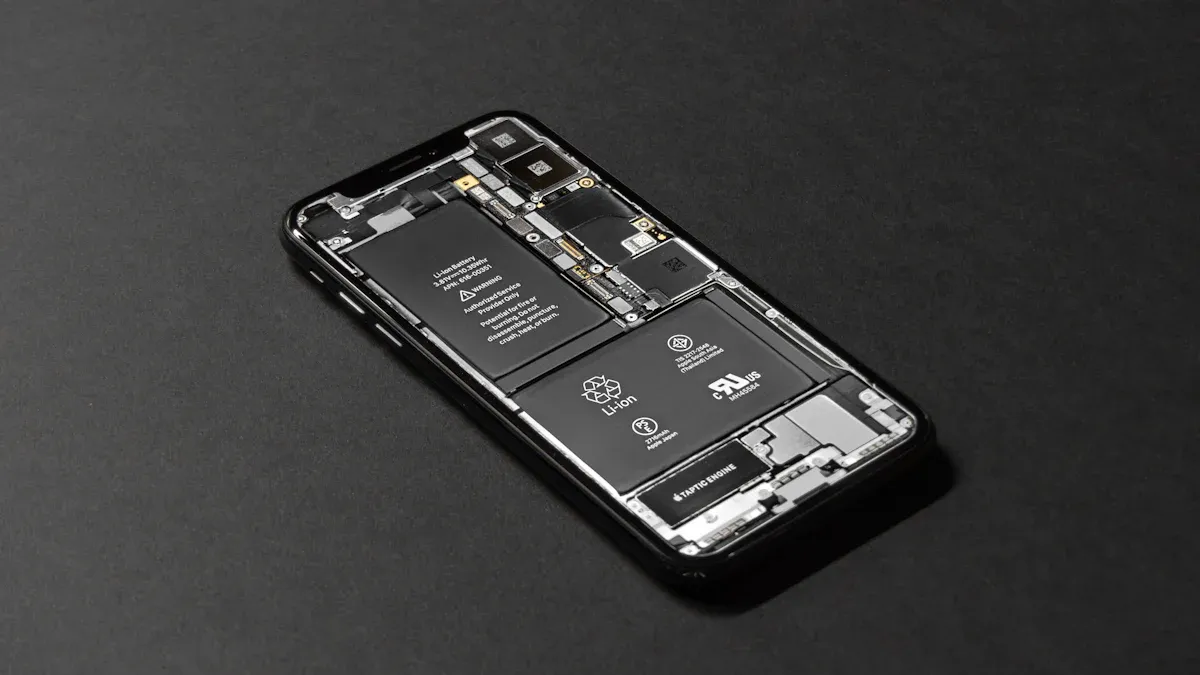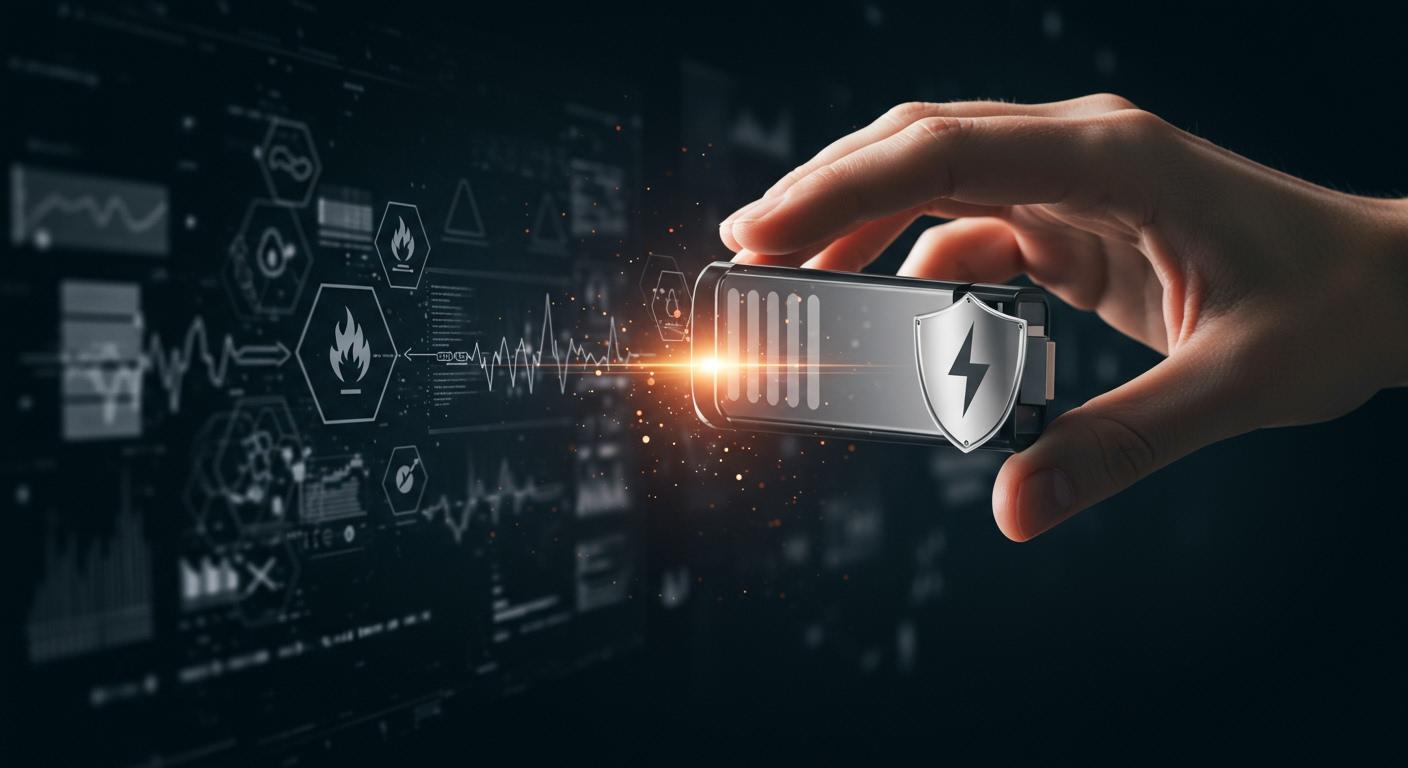The development of a lithium-ion battery that won't catch fire
You can find lithium-ion battery technology that prioritizes safety and reduces fire risks. Battery safety matters because you use these devices in your phone, laptop, and even your car. Fires in portable electronics account for about 70% of reported incidents, with more than 25,000 cases of overheating or fire in five years. Recent breakthroughs offer hope for safer batteries:
| Breakthrough | Description |
|---|---|
| Flexible Lithium-Ion Battery | Designed to withstand extreme conditions without catching fire. |
| Water-in-Salt Electrolytes | New class of electrolytes that reduces flammability and improves safety. |
Key Takeaways
- Recent breakthroughs in lithium-ion battery technology focus on safety, reducing fire risks significantly.
- New designs use fire-retardant materials and advanced electrolytes to prevent overheating and thermal runaway.
- Look for the UL Mark on batteries to ensure they meet strict safety standards and reduce fire hazards.
- Handle devices with care and avoid exposing batteries to extreme heat to prevent accidents.
- The market for fire-safe lithium-ion batteries is expected to grow rapidly, improving safety in consumer electronics and electric vehicles.
Fire-Safe Lithium-Ion Battery

Recent Developments
You see new breakthroughs in lithium-ion battery technology that focus on making power cells safer and more reliable. Traditional lithium-ion batteries often face the risk of thermal runaway, which can lead to dangerous fires. New designs now use fire protection coatings and special intercell materials. These materials have low thermal conductivity and high thermal stability, which help prevent heat from spreading between cells. This improvement marks a big step forward in battery safety.
Several research teams have made important progress in this field:
- Johns Hopkins Applied Physics Laboratory (APL), working with Army researchers and the University of Maryland, created a water-based, fireproof battery. This battery uses a non-flammable electrolyte, so you can use it safely even in extreme conditions. It works at temperatures up to 150 °F without catching fire. The team also introduced hard carbon as an anode material, which helps the battery work better in cold weather than traditional graphite.
- QuantumScape, a leader in solid-state battery development, has focused on replacing flammable liquid electrolytes with solid materials. This change reduces the risk of fire and improves the overall safety of lithium-ion power cells.
- Chinese researchers have developed flexible lithium-ion battery designs that can bend and twist without breaking. These batteries use advanced fire-retardant materials and polymer-based electrolytes, making them much safer for use in wearable devices and flexible electronics.
Note: You benefit from these advancements because they make everyday devices safer and more dependable.
Key Safety Features
Modern lithium-ion battery designs include several features that help prevent fires and improve safety. You can see these improvements in the table below:
| Feature | How It Improves Safety |
|---|---|
| Flame-retardant gel polymer electrolytes | Increases thermal stability and lowers fire hazards |
| Fire-retardant materials | Boosts overall safety and performance of batteries |
| Innovative flexible designs | Stops thermal runaway and adds extra protection |
You also find that these batteries use fire protection coatings and intercell barriers. These features stop heat from moving quickly between cells, which lowers the chance of a fire spreading. Polymer-based electrolytes replace flammable liquids, making the battery less likely to catch fire if damaged. Flexible lithium-ion battery designs allow the battery to bend without breaking, which helps prevent physical damage that could lead to overheating.
The development of these new lithium-ion batteries shows a clear shift toward safer, more reliable energy storage. You can trust that these innovations will make your devices safer and help prevent accidents caused by overheating or fire.
Why Lithium-Ion Batteries Catch Fire
Common Risks
You use current li-ion batteries every day in phones, laptops, and electric vehicles. While these batteries power your devices, they also come with certain risks. Even though incidents are rare, you should know that they are becoming more frequent and can lead to serious consequences. If a lithium-ion battery gets damaged or used incorrectly, it can overheat or even explode. This can cause a catastrophic fire that is hard to put out. Such fires may result in property damage, burns, or exposure to harmful chemicals and smoke.
Some of the most common risks you face with current li-ion batteries include:
- Fire hazards: Batteries can catch fire or explode if punctured, short-circuited, overcharged, or exposed to high temperatures.
- Chemical leaks: Damaged batteries may leak corrosive substances, causing chemical burns and device damage.
- Toxic inhalation: Burning batteries release toxic fumes that can harm your lungs and health.
You also need to watch out for improper usage, incorrect charging, and unsafe disposal. These actions can increase the risk of fire or explosion incidents.
| Vehicle Type | Fire Rate (per 100,000 sold) | Frequency Comparison |
|---|---|---|
| Electric Vehicles (EV) | 25 | Significantly lower |
| Internal Combustion Engine (ICE) | 1,530 | Higher (20 times more) |
Even though electric vehicles have a much lower fire rate than gasoline cars, the combustibility of lithium-ion batteries still makes safety a top concern.
Overheating and Physical Damage
Overheating is one of the main reasons why a lithium-ion battery can fail. When a battery gets too hot, it can enter a state called thermal runaway. This process can lead to a fire or even an explosion. Fires from lithium-ion batteries burn quickly and with intense heat, making them very dangerous and hard to control.
Physical damage is another major safety hazard. If you drop, puncture, or crush a battery, you can cause cracks or short circuits inside. These problems can trigger thermal runaway and increase the risk of fire. Impacts or punctures may break the battery’s internal parts, leading to dangerous failures.
Tip: Always handle your devices with care and avoid exposing batteries to extreme heat or physical shocks. Proper use and storage can help prevent catastrophic fire events.
Safety Innovations

Advanced Electrolytes
You can see major progress in battery safety through the development of advanced electrolytes. These new materials help prevent fires and improve the overall safety and performance of lithium-ion batteries. Scientists have designed electrolytes that combine the best features of both liquids and solids. This approach gives you batteries that work well in a wide range of temperatures and resist damage.
Here is a table that shows some of the most promising advanced electrolytes:
| Advanced Electrolyte Type | Key Features | Safety Improvements |
|---|---|---|
| Quasi-solid state battery | Combines liquid and solid electrolyte properties | High ionic conductivity, broad temperature range |
| Composite material | Exhibits stability when damaged | Increased safety during physical stress |
You also find new types of electrolytes like 3D-SLISE. This material uses amorphous lithium tetraborate, lithium salt, carboxymethyl cellulose, and water. It allows lithium ions to move in all directions, which boosts conductivity and battery life. The 3D-SLISE electrolyte achieves a battery voltage of 2.35 V and can handle over 400 charge and discharge cycles at high rates. Its water-based composition makes recycling easier and safer for the environment.
- 3D-SLISE lets lithium ions move freely, which improves conductivity.
- You get more than 400 cycles at fast charging rates.
- Water-based design supports easier recycling.
Advanced electrolytes also use thermo-responsive features. These features help the battery respond to temperature changes. If the battery gets too hot, the electrolyte or separator can react and stop the battery from overheating. This action lowers the risk of thermal runaway, which is the main cause of battery fires.
Protective Materials
You benefit from new protective materials that make batteries safer and more reliable. Researchers have created composite materials that resist heat and fire. These materials help stop fires before they start and protect the battery during accidents.
Some of the most effective protective materials include:
- Flexible and heat-resistant polyphenylene sulfide ultrafine fiber hybrid separators. These separators keep the battery stable, even if it gets damaged.
- The FR.10 composite, made from carbon fibers and silicone resins. This material is lightweight and thin, but it adds strong fire resistance.
- Polybenzimidazole-based composites. These materials improve fire safety and help batteries work at high temperatures.
You also see batteries with built-in fire suppressants. Laboratory tests show that water mist systems work much better than dry chemical or Class D powder systems. Water mist can put out lithium-ion battery fires and prevent them from starting again. The longer release time of water mist, about 5 minutes, gives you more protection compared to the short bursts from other systems.
Laboratory tests show:
"Water mist is significantly more effective than dry chemical and Class D powder in extinguishing lithium-ion battery fires and preventing reignition. Water mist systems can extinguish fires without reignition due to their longer release time of 5 minutes, compared to the 35-50 seconds for dry chemical and Class D powder systems, which only provide temporary extinguishment."
Companies like KULR Technology, working with NASA, have developed special tools to measure and control heat during battery failures. The fractional thermal runaway calorimeter (FTRC) helps engineers understand how much heat a battery releases during a failure. This knowledge leads to safer battery designs and better ways to stop fires before they spread.
You can trust that these innovations in electrolytes and protective materials are making a real difference. The development of these new technologies means you get batteries that are safer, last longer, and perform better in your devices. As more companies use these solutions, you will see fewer battery fires and more reliable products in your daily life.
Real-World Impact
Consumer Devices
You use lithium-ion batteries every day in your phone, laptop, and other electronics. Fire-safe designs now make these devices much safer. When you buy a device, look for the UL Mark. This mark shows the battery passed strict safety tests. Certified batteries help prevent high temperatures and explosions. You also see public awareness campaigns that teach safe charging habits. These campaigns remind you to buy certified products and avoid cheap, low-quality batteries. Stronger market surveillance now helps keep unsafe batteries off store shelves. UL Solutions warns that non-certified batteries can cause fires. Certification protects you by stopping thermal runaway incidents before they start.
- Look for the UL Mark on batteries and devices.
- Follow safe charging practices.
- Buy only certified products to avoid fire risks.
Electric Vehicles
You see fire-safe lithium-ion batteries making electric vehicles (EVs) safer. Manufacturers use new designs to reduce thermal runaway risks. They divide battery packs into smaller cells with fire-walls. This setup helps contain fires if they start. Less flammable electrolytes also lower fire hazards. These changes make EVs safer than gasoline cars. However, challenges remain. Thermal runaway can still cause temperatures to reach 1000°C in seconds. Fires are hard to control and may reignite hours later. In 2024, Europe saw a 34% rise in EV fires. As more people buy EVs, legal and regulatory challenges grow. Manufacturers face lawsuits and stricter rules because of these risks.
Military Applications
You find fire-safe lithium-ion batteries in military vehicles and equipment. The military faces big risks from battery fires, especially during combat or training. Flammable electrolytes and physical damage can cause internal short circuits. To reduce these dangers, the military uses advanced battery management systems. These systems monitor charging and prevent overheating. Specialized storage solutions also help keep batteries safe. Recent incidents show the need for better storage and handling. Military bases now use strict safety protocols to avoid explosions and financial losses.
Many people still worry about the safety of lithium-ion batteries, especially near homes and schools. Some community leaders say, "We’re not guinea pigs for anybody… we are not going to experiment, we’re not going to take risk." This skepticism slows the adoption of new battery technology.
| Market Segment | Projected CAGR | Forecast Period |
|---|---|---|
| Lithium Battery Fire Extinguisher | 19.4% | 2025 - 2035 |
| Global Lithium-Ion Battery Market | 10.3% | 2025 - 2033 |
| Lithium-Ion Fire Extinguishing Agent | 7.9% | 2025 - 2033 |
You can expect the market for fire-safe lithium-ion batteries to grow quickly. As technology improves and trust builds, you will see safer batteries in more places.
You rely on fire-safe lithium-ion batteries to protect your devices and your safety. These innovations help first responders, improve safety codes, and push industries to adopt better standards.
| Research Objective | Description |
|---|---|
| Hazards to First Responders | Study threats in enclosed spaces |
| Improvement of Codes and Standards | Enhance safety regulations |
Ongoing research explores 3D printing, flame-retardant electrolytes, and new fire suppression methods.
- Future trends include solid-state battery safety and AI-powered hazard detection.
- You can expect stronger regulations as consumer advocates demand action.
Fire-safe batteries will shape the future of technology and safety for everyone.
-

 May.2025.11.24Ternary Lithium Battery vs Lithium-ion: Complete Comparison Guide (2025 Edition)Learn More
May.2025.11.24Ternary Lithium Battery vs Lithium-ion: Complete Comparison Guide (2025 Edition)Learn More -

 May.2025.11.214S2P 18650 14.8V Battery: Complete Technical Guide, Specs, Applications & SafetyLearn More
May.2025.11.214S2P 18650 14.8V Battery: Complete Technical Guide, Specs, Applications & SafetyLearn More -

 May.2025.11.18PCM vs BMS in Lithium Batteries: What’s the Difference and Which One Do You Need?Learn More
May.2025.11.18PCM vs BMS in Lithium Batteries: What’s the Difference and Which One Do You Need?Learn More -

 May.2025.11.17Custom Li-ion Battery Design for Medical Devices (2025 Comprehensive Guide)Learn More
May.2025.11.17Custom Li-ion Battery Design for Medical Devices (2025 Comprehensive Guide)Learn More -

 May.2025.11.17The Future of Lithium-Ion Batteries: Innovation, Sustainability, and Global Market TrendsLearn More
May.2025.11.17The Future of Lithium-Ion Batteries: Innovation, Sustainability, and Global Market TrendsLearn More
















